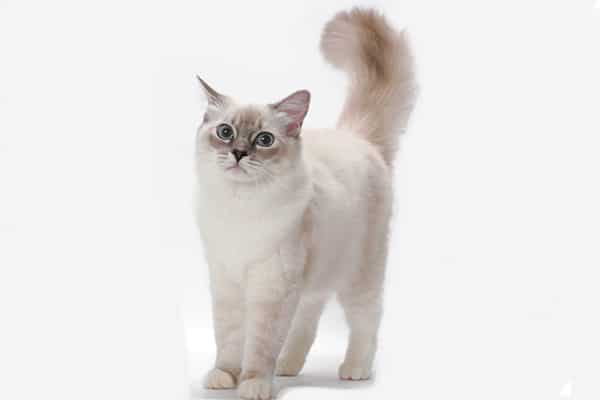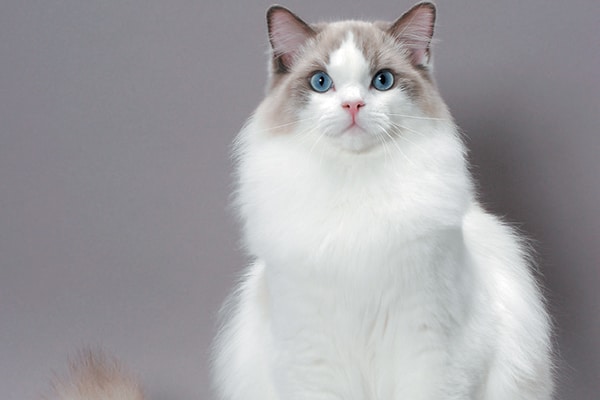The post The Ragdoll Cat — All About This Fascinating Cat Breed by Kim Campbell Thornton appeared first on Catster. Copying over entire articles infringes on copyright laws. You may not be aware of it, but all of these articles were assigned, contracted and paid for, so they aren't considered public domain. However, we appreciate that you like the article and would love it if you continued sharing just the first paragraph of an article, then linking out to the rest of the piece on Catster.com.
It’s easy to fall into the depths of a Ragdoll cat’s glowing, sapphirine eyes, but the real enchantment of these pointed cats with the silky medium-length coat is their gentle and affectionate personality. The Ragdoll cat has a reputation for being a lap cat par excellence, and many enjoy being carried around, cradled like a baby. Among the largest of the cat breeds, a Ragdoll’s weight ranges from 10 to 20 or more pounds, but this breed has a surprisingly small, soft voice.
People who are looking for a quiet, laid-back cat to fill their “empty nest,” travel with them in an RV or be their work-at-home companion will find the people-loving Ragdoll cat to be a good choice. Although he won’t mind snoozing the day away if you have to go off to work, he’ll want to be with you or near you when you’re at home.

Ragdoll cats love to stay at sofa level with their humans. Photography by Tetsu Yamazaki.
Living with a Ragdoll cat
- Ragdolls like doing anything that involves being with their humans, including playing fetch, coming at a run when called and exploring the outdoors on a leash.
- Choose this breed if you’d like a cat who stays at ground or sofa level rather than climbing to the highest point in your home via the curtains.
- When it comes to grooming, the Ragdoll coat doesn’t mat easily, thanks to lack of an undercoat. Brush or comb it thoroughly a couple of times a week to keep it healthy, beautiful and tangle-free. Expect a Ragdoll cat coat to shed in spring and fall.
- Ragdolls who have access to an outdoor play area have been known to chase squirrels and hunt bugs. Those who go outdoors should be limited to a securely fenced area or taken out on a leash.
- Ragdolls do well in families with children who treat them gently. They are also known to buddy up with dogs — they are nicknamed “puppy cats” for good reason — as well as other cats.
What you should know about the breed
- The life span of a healthy Ragdoll cat is 15-plus years. One Ragdoll cat, named Rags, of course, lived to be 19 1⁄2 years old.
- Ragdolls can be prone to a common feline heart condition called hypertrophic cardiomyopathy. Fortunately, cats with the gene that causes the disease can be identified through a DNA test. This allows conscientious breeders to produce cats free of the condition.
- It’s not true that Ragdolls are resistant to pain. Like any cat, they can be hurt or feel discomfort.
- The best people for a Ragdoll cat will enjoy combing this cat’s gorgeous bunny-soft tresses. They adore having a cat in their lap and won’t mind constant Ragdoll supervision of their activities.

The Ragdoll cat breeds traces its roots to the 1960s. Photography by Tetsu Yamazaki.
History of the Ragdoll cat
- The Ragdoll cat breed dates to the 1960s, when a California woman named Ann Baker bred a free-roaming white female cat with longish hair to a stray black-and-white male with white paws, or mittens. Their kittens — a solid black male, a bicolor sealpoint female and a longhaired brown male became the forebears of the Ragdolls, a name based on the cats’ tendency to loll in a lap or be carried around without resistance.
- The Cat Fanciers’ Association, The International Cat Association and the American Cat Fanciers Association recognize the Ragdoll.
- The Ragdoll cat is second only to the Exotic in popularity, according to the 2017 Cat Fanciers’ Association registration stats. In The International Cat Association, it ranks second following the Bengal.
More fun facts about the breed
- Ragdoll kittens are white at birth, but by the time they are 10 days old their points and patterns make an appearance.
- Similar to an old-style Polaroid photograph, coat color and length take time to fully develop, usually reaching peak display when the cat is 2 to 3 years old.
- They reach their full weight when approximately 4 years old.
- Ragdolls come in four patterns:
- Bi-color (white, plus a solid color, with both evenly distributed)
- Van (white with small spots of darker color at the top of the mask, on the ears and tail and occasionally on the body)
- Mitted (four white paws, a white chin and a white belly stripe)
- Colorpoint (classic pointed markings in solid, lynx, tortoiseshell or tortoiseshell and lynx, with no white on the coat).
- The patterns come in six colors:
- Seal
- Blue
- Chocolate
- Lilac
- Red
- Cream
Tell us: Do you have a Ragdoll cat? What do you love about this breed?
Read Next: Meet the Magical Norwegian Forest Cat
The post The Ragdoll Cat — All About This Fascinating Cat Breed by Kim Campbell Thornton appeared first on Catster. Copying over entire articles infringes on copyright laws. You may not be aware of it, but all of these articles were assigned, contracted and paid for, so they aren't considered public domain. However, we appreciate that you like the article and would love it if you continued sharing just the first paragraph of an article, then linking out to the rest of the piece on Catster.com.
Kim Campbell Thornton